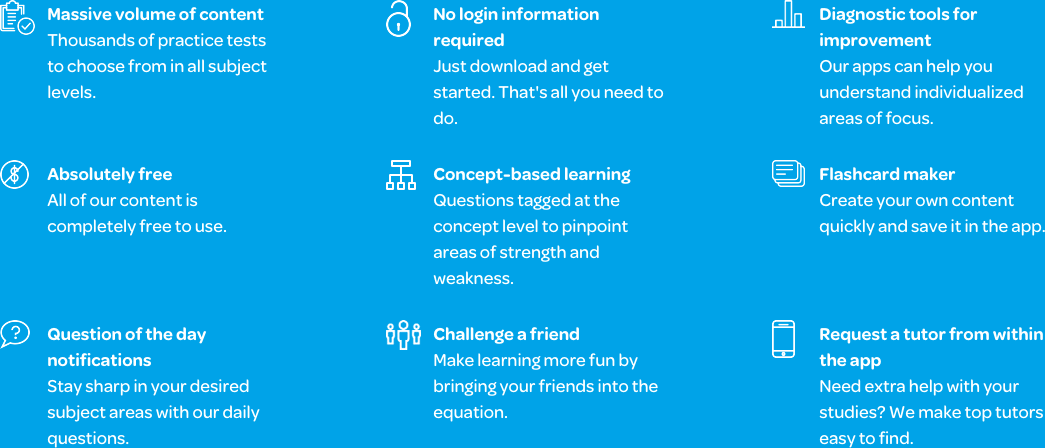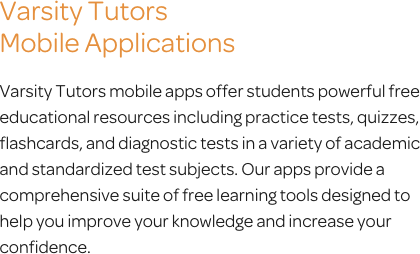The Varsity Tutors AP Human Geography Mobile App
Students can pursue a range of college-level studies ahead of time through the Advanced Placement Program. AP Human Geography is one of the areas where you can earn AP or college credit before leaving high school. It focuses on the patterns and processes by which humans have impacted the Earth’s surface, covering spatial concepts, socioeconomic organization, the environment, landscape analysis, and the methods and tools used by geographers. While there are no prerequisite courses or skills, save for reading at a college level, there are many topics to review for the exam. The Varsity Tutors AP Human Geography app, available for iOS and Android devices, can make your study time more efficient; it is available at the Google Play Store and on iTunes.
AP Human Geography requires you to interpret maps, analyze geospatial data, and identify networks of phenomena and understand how they are associated and what the implications are. Recognizing patterns at different scales is essential. The course requires you to define regions and identify and assess interconnected, fluctuating processes at the regional level. The need to characterize and analyze them takes practice and patience, but the AP Human Geography app provides the tools necessary to become familiar with this and other core concepts.
The main topics of the course and exam include geography, population and migration, cultural patterns and processes, political organization, industrialization/economic development, and cities/ urban land use. Rural land use, in regard to agriculture and food production, is covered as well. The AP Human Geography Exam is two hours and fifteen minutes. In Section I, there are 75 multiple choice questions, which you have 60 minutes to answer. There are just three questions in Section II, but they are half of the exam score. In 75 minutes, you may have to analyze/evaluate geographical concepts, explain real-world examples related to these, interpret maps/graphs/photos/diagrams or verbal descriptions, and provide narrative responses.
To help you prepare for the exam and supplement your class studies, the AP Human Geography app provides Full-Length Practice Tests that cover the same content found on the actual exam. When taking one of these, you can see what you know and don’t know. The scoring page at the end compares your score to all other test-takers, both overall and for each individual question. After answering the questions, you are provided detailed explanations, which can help improve your knowledge even if you answered right. You can even track your speed and share your results with friends, teachers, and tutors.
Other tools include shorter topical tests; the Learn by Concept interactive syllabus, in which you can drill down to questions on specific topics; and the Question of the Day, which provides brief one-question reviews using concepts drawn from the longer tests. The randomness can help you with memorizing and becoming more familiar with the exam format. In addition, flashcards are available, enabling you to pick specific topics and get immediate answers to each question. You can move on to as many as are available, or do just a few, without being timed or scored. The app allows you to use pre-made flashcards or even make your own with unique pictures, text, and video on your smartphone.
The AP Human Geography app provides hundreds of tests and study materials to help you prepare in advance for the exam. Download the app for iPad, iPhone, or Android devices today!
66 mobile apps to choose from for your tutoring needs.

Learn More
Among the many Advanced Placement courses available in the social sciences, AP Human Geography stands out as a particularly unique offering. Unlike many other geography courses that present content regionally, the material in AP Human Geography is presented by theme. The course covers four main subdisciplines: cultural geography, economic geography, urban geography, and political geography. Historical information and case studies combine to give students a deeper understanding of the modern world. AP Human Geography gives students the opportunity to become multicultural, geoliterate citizens who are engaged in issues affecting the world today. You can practice mastering these topics with the AP Human Geography app from Varsity Tutors, available as a free download for any iPhone, iPad, or Android-powered device.
AP Human Geography is roughly equivalent to an introductory-level college course. The course standards are based on the 2012 National Geography Standards, and by the end of the class, students should be proficient in college-level skills like interpreting geospatial data and maps, understanding the connections among and implications of events in terms of geography, analyzing and interpreting relationships between processes and patterns, and evaluating regionalization. AP Human Geography emphasizes interdisciplinary thinking, and asks students to consider the geographic perspective when thinking about various issues. There are seven major areas covered by the curriculum, including geography’s nature and perspectives; the political organization of space; agriculture, food production, and rural land use; population and migration; cultural patterns and processes; industrialization and economic development; and cities and urban land use. The free Varsity Tutors AP Human Geography app covers all of these topics in-depth, and you can download it from iTunes or the Google Play Store.
The course begins with an overview of geography and the spatial perspective from which students are expected to view issues. The importance of the field of geography is explored, and the problem-solving and critical thinking skills made possible through the study of human geography are discussed. Students will learn to view the human organization of space through the lens of landscape analysis and spatial thinking. Other important geographical skills, like the interpretation and use of a variety of types of maps, are also introduced in this unit. As maps are one of the most frequently used documents in this class, their types, uses, and projections are thoroughly reviewed. Geographic issues will be examined using concepts like region, place, and space, as will the regions of the world and their regionalization processes. Finally, students will learn to use and interpret both qualitative and quantitative geographic and geospatial data.
Next, AP Human Geography moves on to look at population and migration, which examines the effect that geographic patterns have on the distribution, composition, and density of populations. The growth and decline of populations over time and space are also discussed, and students should be able to explain their historical and contemporary trends, interpret theories of growth and decline, and evaluate population policies on a national and international basis. The push and pull factors of migration are also covered, including cultural, demographic, economic, environmental, and political causes. Students will analyze historical migrations of note, and evaluate the political, environmental, economic, and cultural repercussions of migration.
After establishing the quantitative qualities of human geography, the course will look at the cultural processes and patterns that shape a society’s shared behaviors. Maps will continue to be emphasized in this unit, as students will learn how geographers use maps to analyze the spatial and place of ethnic and religious groups. Maps will also be used to explain the patterns and distributions of gender, language, religion, and ethnicity. The effects of globalization and technology will also be introduced in this unit. Students will be expected to be able to explain how and why cultural traits diffuse through geographic space and time, and to ably compare and contrast the geographic patterns associated with popular and folk culture.
The course then moves on to analyze the political organization of space, just one area where a comprehensive set of study tools, like those available from Varsity Tutors’ AP Human Geography app for iOS and Android devices, can help you prepare yourself for the final exam. To foster students’ understanding of the contemporary political map, the structure, evolution, and influence of geopolitical forces will be explored. The concepts of territoriality and political power will also be delved into, as will the functions and nature of internal and international boundaries. There will be detailed discussion of the various forms of governance as well, including governance at the local and metropolitan levels.
Agriculture, food production, and rural land use are all influenced by geography, and students will first learn about the earliest centers of domestication. Next, the effects and patterns of diffusion of plants, animals, and agricultural practices will be discussed. The positive and negative consequences of modern advances and the Green Revolution on the environment and our food supply are analyzed, including a reduction in global hunger and the adverse effects agricultural alterations have on the environment. The physical geography, economic forces, and spatial organization of agricultural regions is also explored, as are the challenges and opportunities presented by contemporary agriculture. AP Human Geography also touches upon industrialization and economic development, and students will be required to use their mathematics skills to evaluate measures of social and economic development. This unit will also ask students to analyze international trade and its influence upon social and economic development on a global scale.
Lastly, cities and urban land use are discussed. The evolution of the sites, situations, and sizes of urban settlements will be explored, as well as the effects of transportation, communication, migration, and political influence upon them. The architecture and design of residential and shared spaces is analyzed; in particular, the way it reflects a population’s values and attitudes. A discussion of the issues faced by modern urban areas concludes the course, and places an emphasis on problem-solving and sustainability.
The AP Human Geography Exam has both multiple-choice questions and constructed response questions. Section I of the exam contains 75 multiple-choice questions, which will test students on their ability to interpret geographic data and concepts. It must be finished within one hour. Section II of the exam is 75 minutes long, and consists of three constructed response questions. These questions may ask students to use their skills in synthesis, analysis, and interpretation to explain a variety of geographic concepts. The questions may be accompanied by maps, graphs, diagrams, or photographs. It is well worth the effort it takes to prepare adequately, as scoring well on the AP Human Geography Exam can provide students with the opportunity to be placed in more advanced courses, or even to be granted college credit. When you’re ready to get serious about your efforts, download the free Varsity Tutors AP Human Geography app from iTunes or the Google Play Store.




